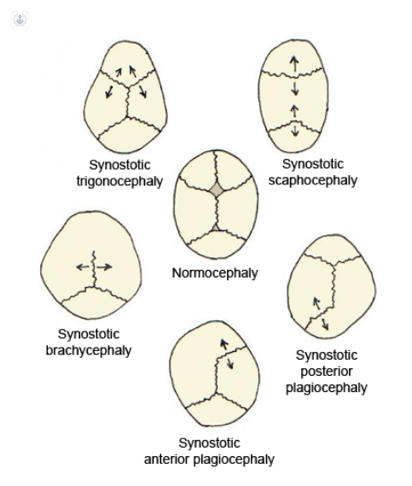


What is craniosynostosis?
Craniosynostosis is a problem with the growth and development of the skull in childhood. Normally, the skull of a child is made up of a number of plates which fit together but don’t fuse until adulthood. In craniosynostosis, some of these plates fuse early, causing the skull to have an irregular shape.
Craniosynostosis is a rare condition, affecting just 1 in every 1,800 to 3,000 children – mostly boys.

Symptoms of craniosynostosis
Usually the thing which parents notice most is that their child’s head is an irregular shape. Other signs of craniosynostosis include:
Some children experience raised intracranial pressure (ICP), where pressure inside your child’s skull builds up because of its shape. If the condition is mild, your child might not experience ICP until they are between four and eight years old. Symptoms of ICP can include:
In more serious (untreated) cases, intracranial pressure can cause vomiting, hearing difficulties, and even breathing difficulties.
How is craniosynostosis diagnosed?
Craniosynostosis is diagnosed by a paediatrician who will conduct a visual examination of your child’s head and may take measurements. They may refer you to a specialist centre for an X-ray or MRI scan to confirm the diagnosis and determine what type of craniosynostosis your child has.
What causes craniosynostosis?
Craniosynostosis can be classified as either nonsyndromic (no birth defects or the cause is unknown) or syndromic (caused by a rare syndrome).
There are over 150 rare syndromes which can cause craniosynostosis, and these are usually genetic. The vast majority of cases, however – over 80% of cases – are nonsyndromic.
How is craniosynostosis treated?
In many cases, craniosynostosis doesn’t need treatment. Instead, your child will have regular check-ups with the paediatrician to monitor their condition and check if it’s causing any symptoms.
Treatment is generally only considered if your child is experiencing some of the symptoms described above, or where the shape of their skull could affect their brain development or self-esteem when they are older.
Craniosynostosis is treated with skull surgery. This might be carried out when your child is a baby or delayed until later in life. The reason for considering a delay in surgery is to reduce the risk of needing repeat surgery.
There are two types of craniosynostosis surgery:
Craniosynostosis surgery is usually carried out by a team composed of a craniofacial surgeon and a neurosurgeon.